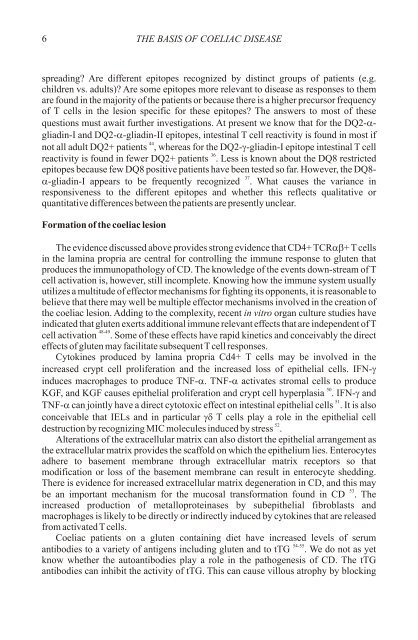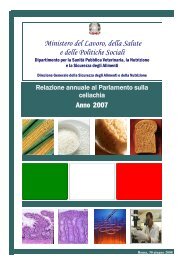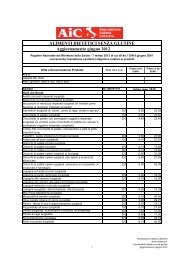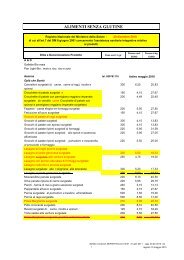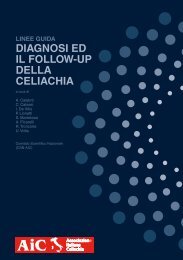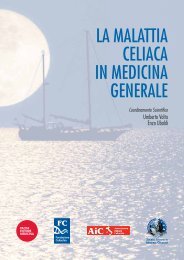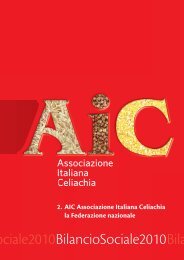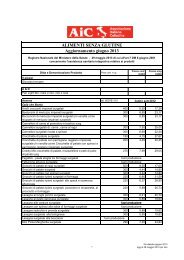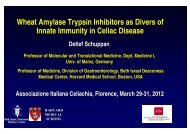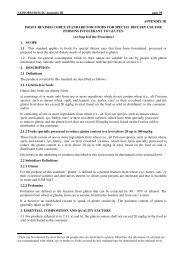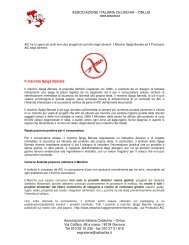primary prevention of coeliac disease - Associazione Italiana ...
primary prevention of coeliac disease - Associazione Italiana ...
primary prevention of coeliac disease - Associazione Italiana ...
Create successful ePaper yourself
Turn your PDF publications into a flip-book with our unique Google optimized e-Paper software.
6 THE BASIS OF COELIAC DISEASE<br />
spreading? Are different epitopes recognized by distinct groups <strong>of</strong> patients (e.g.<br />
children vs. adults)? Are some epitopes more relevant to <strong>disease</strong> as responses to them<br />
are found in the majority <strong>of</strong> the patients or because there is a higher precursor frequency<br />
<strong>of</strong> T cells in the lesion specific for these epitopes? The answers to most <strong>of</strong> these<br />
questions must await further investigations. At present we know that for the DQ2-agliadin-I<br />
and DQ2-a-gliadin-II epitopes, intestinal T cell reactivity is found in most if<br />
44<br />
not all adult DQ2+ patients , whereas for the DQ2-g-gliadin-I epitope intestinal T cell<br />
36<br />
reactivity is found in fewer DQ2+ patients . Less is known about the DQ8 restricted<br />
epitopes because few DQ8 positive patients have been tested so far. However, the DQ8-<br />
37<br />
a-gliadin-I appears to be frequently recognized . What causes the variance in<br />
responsiveness to the different epitopes and whether this reflects qualitative or<br />
quantitative differences between the patients are presently unclear.<br />
Formation <strong>of</strong> the <strong>coeliac</strong> lesion<br />
The evidence discussed above provides strong evidence that CD4+ TCRab+ T cells<br />
in the lamina propria are central for controlling the immune response to gluten that<br />
produces the immunopathology <strong>of</strong> CD. The knowledge <strong>of</strong> the events down-stream <strong>of</strong> T<br />
cell activation is, however, still incomplete. Knowing how the immune system usually<br />
utilizes a multitude <strong>of</strong> effector mechanisms for fighting its opponents, it is reasonable to<br />
believe that there may well be multiple effector mechanisms involved in the creation <strong>of</strong><br />
the <strong>coeliac</strong> lesion. Adding to the complexity, recent in vitro organ culture studies have<br />
indicated that gluten exerts additional immune relevant effects that are independent <strong>of</strong> T<br />
48-49<br />
cell activation . Some <strong>of</strong> these effects have rapid kinetics and conceivably the direct<br />
effects <strong>of</strong> gluten may facilitate subsequent T cell responses.<br />
Cytokines produced by lamina propria Cd4+ T cells may be involved in the<br />
increased crypt cell proliferation and the increased loss <strong>of</strong> epithelial cells. IFN-g<br />
induces macrophages to produce TNF-a. TNF- activates stromal cells to produce<br />
50<br />
KGF, and KGF causes epithelial proliferation and crypt cell hyperplasia . IFN-gand<br />
51<br />
TNF-acan jointly have a direct cytotoxic effect on intestinal epithelial cells . It is also<br />
conceivable that IELs and in particular gdT cells play a role in the epithelial cell<br />
52<br />
destruction by recognizing MIC molecules induced by stress .<br />
Alterations <strong>of</strong> the extracellular matrix can also distort the epithelial arrangement as<br />
the extracellular matrix provides the scaffold on which the epithelium lies. Enterocytes<br />
adhere to basement membrane through extracellular matrix receptors so that<br />
modification or loss <strong>of</strong> the basement membrane can result in enterocyte shedding.<br />
There is evidence for increased extracellular matrix degeneration in CD, and this may<br />
53<br />
be an important mechanism for the mucosal transformation found in CD . The<br />
increased production <strong>of</strong> metalloproteinases by subepithelial fibroblasts and<br />
macrophages is likely to be directly or indirectly induced by cytokines that are released<br />
from activated T cells.<br />
Coeliac patients on a gluten containing diet have increased levels <strong>of</strong> serum<br />
54-55<br />
antibodies to a variety <strong>of</strong> antigens including gluten and to tTG . We do not as yet<br />
know whether the autoantibodies play a role in the pathogenesis <strong>of</strong> CD. The tTG<br />
antibodies can inhibit the activity <strong>of</strong> tTG. This can cause villous atrophy by blocking


